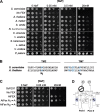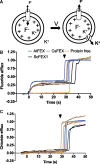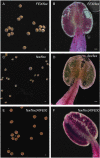The fluoride transporter FLUORIDE EXPORTER (FEX) is the major mechanism of tolerance to fluoride toxicity in plants
- PMID: 33744970
- PMCID: PMC8195535
- DOI: 10.1093/plphys/kiab131
The fluoride transporter FLUORIDE EXPORTER (FEX) is the major mechanism of tolerance to fluoride toxicity in plants
Abstract
Fluoride is everywhere in the environment, yet it is toxic to living things. How biological organisms detoxify fluoride has been unknown until recently. Fluoride-specific ion transporters in both prokaryotes (Fluoride channel; Fluc) and fungi (Fluoride Exporter; FEX) efficiently export fluoride to the extracellular environment. FEX homologues have been identified throughout the plant kingdom. Understanding the function of FEX in a multicellular organism will reveal valuable knowledge about reducing toxic effects caused by fluoride. Here we demonstrate the conserved role of plant FEX (FLUORIDE EXPORTER) in conferring fluoride tolerance. Plant FEX facilitates the efflux of toxic fluoride ions from yeast cells and is required for fluoride tolerance in plants. A CRISPR/Cas9-generated mutation in Arabidopsis thaliana FEX renders the plant vulnerable to low concentrations (100 µM) of fluoride at every stage of development. Pollen is particularly affected, failing to develop even at extremely low levels of fluoride in the growth medium. The action of the FEX membrane transport protein is the major fluoride defense mechanism in plants.
© The Author(s) 2021. Published by Oxford University Press on behalf of American Society of Plant Biologists. All rights reserved. For permissions, please email: journals.permissions@oup.com.
Figures










Similar articles
-
The fluoride transporter FLUORIDE EXPORTER (FEX) is the major mechanism of tolerance to fluoride toxicity in plants1.Plant Physiol. 2021 Mar 21:kiab131. doi: 10.1093/plphys/kiab131. Online ahead of print. Plant Physiol. 2021. PMID: 33787927
-
Fluoride transport in Arabidopsis thaliana plants is impaired in Fluoride EXporter (FEX) mutants.Plant Mol Biol. 2024 Feb 11;114(1):17. doi: 10.1007/s11103-023-01413-w. Plant Mol Biol. 2024. PMID: 38342783 Free PMC article.
-
Fluoride export (FEX) proteins from fungi, plants and animals are 'single barreled' channels containing one functional and one vestigial ion pore.PLoS One. 2017 May 4;12(5):e0177096. doi: 10.1371/journal.pone.0177096. eCollection 2017. PLoS One. 2017. PMID: 28472134 Free PMC article.
-
Membrane Exporters of Fluoride Ion.Annu Rev Biochem. 2021 Jun 20;90:559-579. doi: 10.1146/annurev-biochem-071520-112507. Epub 2021 Jan 25. Annu Rev Biochem. 2021. PMID: 33492991 Free PMC article. Review.
-
Implications of metal accumulation mechanisms to phytoremediation.Environ Sci Pollut Res Int. 2009 Mar;16(2):162-75. doi: 10.1007/s11356-008-0079-z. Epub 2008 Dec 6. Environ Sci Pollut Res Int. 2009. PMID: 19067014 Review.
Cited by
-
The role of plant growth promoting rhizobacteria in strengthening plant resistance to fluoride toxicity: a review.Front Microbiol. 2023 Oct 10;14:1271034. doi: 10.3389/fmicb.2023.1271034. eCollection 2023. Front Microbiol. 2023. PMID: 37901824 Free PMC article. Review.
-
Reasons why life on Earth rarely makes fluorine-containing compounds and their implications for the search for life beyond Earth.Sci Rep. 2024 Jul 6;14(1):15575. doi: 10.1038/s41598-024-66265-w. Sci Rep. 2024. PMID: 38971876 Free PMC article.
-
Lanthanum-fluoride electrode-based methods to monitor fluoride transport in cells and reconstituted lipid vesicles.Methods Enzymol. 2024;696:43-63. doi: 10.1016/bs.mie.2024.01.012. Epub 2024 Feb 9. Methods Enzymol. 2024. PMID: 38658088 Free PMC article.
-
A simple and low-cost method for fluoride analysis of plant materials using alkali extraction and ion-selective electrode.Plant Methods. 2025 Jul 17;21(1):98. doi: 10.1186/s13007-025-01412-6. Plant Methods. 2025. PMID: 40676672 Free PMC article.
-
Evaluating the Response of the Soil Bacterial Community and Lettuce Growth in a Fluorine and Cadmium Co-Contaminated Yellow Soil.Toxics. 2024 Jun 25;12(7):459. doi: 10.3390/toxics12070459. Toxics. 2024. PMID: 39058111 Free PMC article.
References
-
- Agarwal M, Rai K, Shrivastav R, Dass S (2002) A study on fluoride sorption by montmorillonite and kaolinite. Water Air Soil Pollut 141: 247–261
-
- Anbuvel D, Kumaresan S, Margret RJ (2014) Fluoride analysis of soil in cultivated areas of Thovalai channel in Kanyakumari district, Tamil Nadu, India: correlation with physico-chemical parameters. Int J Basic Appl Chem Sci 4: 20–29
-
- Barnes JD, Balaguer L, Manrique E, Elvira S, Davison AW (1992) A reappraisal of the use of DMSO for the extraction and determination of chlorophylls a and b in lichens and higher plants. Environ Exp Bot 32: 85–100
LinkOut - more resources
Full Text Sources
Other Literature Sources

